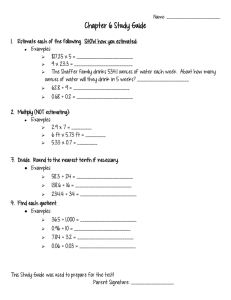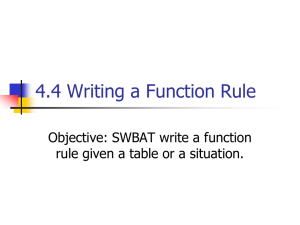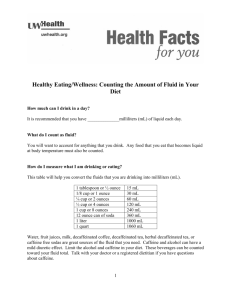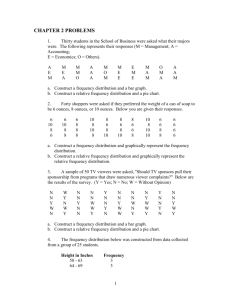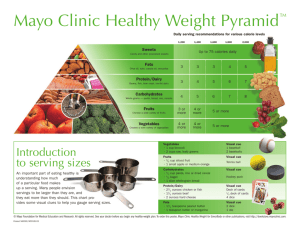Healthy nutrition for everyone
advertisement
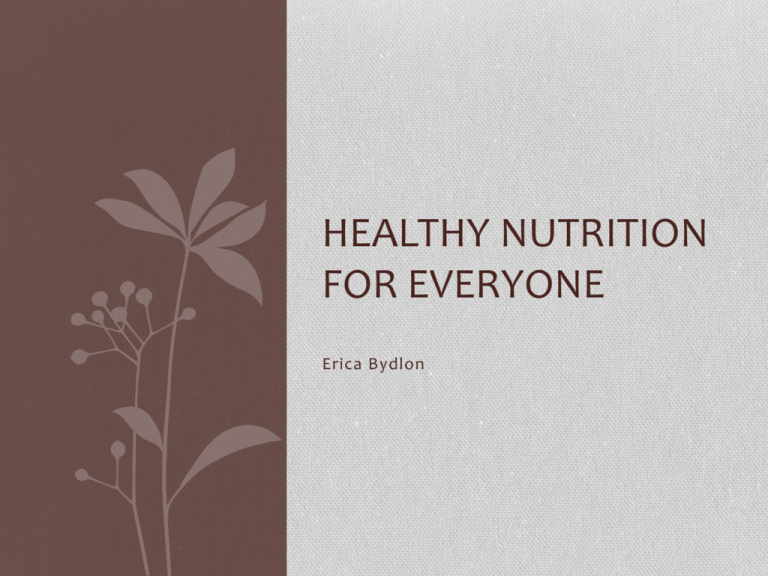
HEALTHY NUTRITION FOR EVERYONE Erica Bydlon Lets start with the basics… Fruit! • The sweet and fleshy product of a tree or other plant that contains seed and can be eaten as food! • Key thing to remember with fruit is that the fresher it is the better! Try to stay away from “canned fruits” • Examples: Apples, Bananas, Strawberries, Kiwi, blueberries, grapes and many more! • Fruit is full of vitamins, antioxidants, and fiber Vegetables • According to “My plate” vegetables is broken up into 5 subgroups • Dark Green Vegetables = broccoli, kale, romaine lettuce, spinach, watercress • Starch vegetables = corn, green peas, potatoes, taro, water chestnuts • Red & Orange vegetables = acorn squash, carrots, pumpkin, red peppers, sweet potatoes, tomatoes • Beans and Peas = black beans, kidney beans, soy beans, lentils, split peas • Other vegetables = asparagus, avocado, bean sprouts, beets, cabbage, celery, cucumbers, egg plants, green beans, green peppers, onions, zucchini Serving size of Fruits/Vegetables • *From the USDA’s my plate…and remember each individual is different and may have different needs! • Fruits = 1 ½ or 2 cups a day • 1 large banana = 1 cup • 1 small apple = 1 cup • 8 large strawberries • Vegetables = 2 or 3 cups a day • 1 cup of spinach • 1 cup of sliced cucumbers • 1 cup of baby carrots (about 12) Grains • Split into 2 groups “Whole Grains” and “Refined Grains” • Whole Grain: contains the entire grain kernel (bran, germ, and endosperm • Whole- wheat flour, oatmeal, whole cornmeal, brown rice, popcorn, whole wheat pasta, whole wheat tortillas • Refined Grain: have been milled, removes the grain. It is done so to improve shelf life but removes fiber, iron and vitamins • White flour, white bread, white rice, noodles, cornbread, crackers, pretzels • However, most refined grains are enriched which means they put back certain vitamins after the processing Serving Size of Grains • * according to the USDA my plate • Women 19+ = 6 ounces daily • Men 19+ = 8 ounces daily • Of those ounces, 3 ounces for women should be whole grains and 4 for men • 1 “mini” bagel = 1 ounce • 1 “large” bagel = 4 ounces • 2 slices of bread = 2 ounces • ½ cup cooked oatmeal = 1 ounce • ½ cup cooked rice = 1 ounce Proteins • All foods made from meat, poultry, seafood, beans, eggs, it includes many foods • Beef, ham, lamb, bison, pork, chicken, turkey, eggs, chickpeas, almonds, cashews, peanuts, sunflower seeds, cod, flounder, salmon, snapper, tuna, shrimp, crab, clams , lobster • Proteins are the building blocks for bones, muscles, skin and blood. • Vitamins found in protein rich foods help play a vital role in our nervous system • Iron, carries oxygen in the blood- very important for women of child bearing age and because iron-deficiency anemia is common! Serving Size of Proteins • * According to the USDA’s my plate • Women 19-30 = 5 ½ ounces • Women 30+ = 5 ounces • Men 19-30 = 6 ½ ounces • Men 30- 50 = 6 ounces • Men 51+ = 5 ½ ounce • 1 ounce cooked lean beef ( 1 small steak/ filet ) • 1 small lean hamburger = 2 to 3 ounces • 1 egg = 1 ounce • 2 tablespoons hummus = 1 ounce Dairy • Many dairy products come from milk or made of milk • Skim milk, low fat milk, reduced fat milk, lactose free, puddings, frozen yogurt, ice cream, yogurt, cheese, mozzarella, swiss, ricotta, american • Intake of dairy can improve bone health and may reduce risk of osteoporosis • Intake of diary is also associated with reduced risk of cardiovascular disease and type 2 diabetes Serving Size of Diary • *According to USDA’s my plate • Women and Men 19+ = 3 cups • 1 cup yogurt • 1 snack size container of yogurt • 1 slice of processed cheese = 1/3 cup • 1 scoop ice cream = 1/3 cup Oils • Oils are fats at liquid temperature, not a food group but they do provide essential nutrients • Canola oil, corn oil, olive oil, nuts, olives, some fish, avocadoes (naturally high in oils), butter, milk fat, stick margarine • Serving Size of Oils • Women 19- 30 = 6 teaspoons • Women 31+ = 5 teaspoons • Men 19-30 = 7 teaspoons • Men 31 + = 6 teaspoons Portion Size • Be careful! Most of our portions today are double what they use to be! • 20 years ago a blueberry muffin was 210 calories , 1.5 ounces • Today, the average blueberry muffin which is about 5 ounces has 500 calories • 20 years ago a 8 ounce coffee with whole milk and sugar was 45 calories • Today, a 16 ounce coffee has 350 calories • It would take an hour and twenty minutes of walking to burn 305 calories • (based on a 130 pound person) References • http://www.choosemyplate.gov/index.html • GREAT resource!


